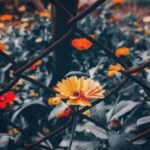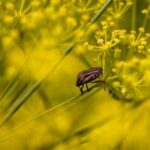Butterfly garden plans the layout and design to create a welcoming space for these delicate creatures. When it comes to designing a butterfly garden, there are a few key factors to consider in order to attract and sustain these colorful insects. From selecting the right location to choosing the best plants, creating a butterfly-friendly environment requires careful planning and thought.
Butterfly gardens have become increasingly popular as more people seek to support local ecosystems and enjoy the beauty of these winged wonders. By intentionally designing a space that caters to the needs of butterflies, you can create an oasis that not only benefits these pollinators but also adds vibrant color and life to your outdoor environment.
In this article, we will explore the importance of layout and design in butterfly gardens, including tips on choosing the right location, selecting plants for attracting butterflies, creating a color scheme, adding water features, incorporating host plants for caterpillars, and maintaining your butterfly garden. Whether you’re new to gardening or looking to enhance your existing landscape, this guide will provide valuable insights into creating a thriving butterfly habitat in your own backyard.
The Importance of Layout and Design in Butterfly Gardens
When planning a butterfly garden, the layout and design are crucial factors to consider in order to attract butterflies and create a beautiful outdoor space. The arrangement of plants, flowers, and other elements can greatly impact the success of your butterfly garden. Consider the following tips for creating an effective layout and design for your butterfly garden:
1. **Grouping Plants:** When designing your butterfly garden, it is important to group plants together based on their height and blooming season. This will not only create a visually appealing display but also make it easier for butterflies to navigate through the garden while seeking nectar.
2. **Choosing Focal Points:** Incorporating focal points like large flowering plants, decorative rocks, or ornamental structures can add visual interest to your butterfly garden. These focal points can also serve as resting spots for butterflies and create opportunities for unique photographic moments.
3. **Creating Pathways:** Designing pathways within your butterfly garden not only allows easy access for maintenance but also provides an opportunity for visitors to leisurely stroll through the garden while observing the delicate creatures fluttering around.
By carefully considering the layout and design of your butterfly garden, you can create an inviting habitat that will attract and sustain many species of butterflies while adding natural beauty to your outdoor space.
Choosing the Right Location for Your Butterfly Garden
Selecting the right location for your butterfly garden is crucial to its success. Butterflies are attracted to sunny spots, so it is important to choose a location that receives at least six hours of sunlight each day. This will not only attract more butterflies but also ensure that the host and nectar plants in your garden thrive.
In addition to sunlight, it is important to consider wind exposure when choosing a location for your butterfly garden. While some wind is beneficial as it helps to keep butterflies airborne, too much wind can be damaging to both the plants and the delicate butterfly wings. Consider planting your garden near a fence or hedge to provide some protection from strong winds.
Another factor to consider when choosing the right location for your butterfly garden is proximity to water sources. Butterflies require water not just for drinking but also for reproduction. Placing your garden near a water source such as a birdbath or pond will attract more butterflies and provide them with the resources they need to thrive.
| Location Consideration | Importance |
|---|---|
| Sunlight | Attracts butterflies and ensures plant growth |
| Wind Exposure | Protects plants and butterflies from damage |
| Proximity to Water Sources | Attracts butterflies and provides necessary resources |
Selecting the Best Plants for Attracting Butterflies
When it comes to creating a successful butterfly garden, one of the most important aspects to consider is selecting the best plants for attracting butterflies. Butterflies are attracted to nectar-producing flowers, so it’s essential to choose a variety of plants that will provide them with the food they need. Incorporating a diverse selection of flowers will not only attract a wide range of butterfly species but also add visual interest and color to your garden.
Native Plants
One key factor in selecting plants for your butterfly garden is choosing native species. Native plants have evolved alongside local butterfly species and are well adapted to the climate, soil, and other environmental factors in your area. By including native plants in your garden, you can create a habitat that closely mimics the natural environment, making it more appealing and beneficial for butterflies.
Nectar-Rich Flowers
It’s important to include a variety of nectar-rich flowers in your butterfly garden to provide butterflies with the sustenance they need. Some popular choices include coneflowers, milkweed, black-eyed Susans, lantana, and verbena. These types of flowers are not only attractive to butterflies but also easy to maintain and will bloom throughout the growing season, ensuring a continuous food source for these beautiful insects.
Host Plants
In addition to nectar-producing flowers, it’s crucial to incorporate host plants in your butterfly garden. Host plants provide a place for butterflies to lay their eggs and serve as food sources for caterpillars.
Different species of butterflies have specific host plant requirements, so including a variety of native host plants will attract a greater diversity of butterfly species to your garden. For example, monarch butterflies rely on milkweed as their sole host plant, so including this essential plant is crucial for supporting their life cycle.
By carefully selecting a variety of native nectar-rich flowers and host plants for your butterfly garden, you can create an inviting habitat that will attract and support a diverse array of beautiful butterflies. Paying attention to the specific needs and preferences of local butterfly species when choosing plants will ensure that your garden becomes a bustling hub for these captivating creatures.
Creating a Color Scheme for Your Butterfly Garden
When planning and designing your butterfly garden, one important aspect to consider is the color scheme. Butterflies are attracted to certain colors, so choosing the right plants with the right colors will not only enhance the beauty of your garden but also increase its appeal to butterflies.
Understanding Butterfly Preferences
Different species of butterflies are attracted to different colors. For example, brightly colored flowers such as red, yellow, pink, and purple are known to attract butterflies like the Monarch, Swallowtail, and Painted Lady. Understanding the preferences of local butterfly species will help you choose plants with the right colors for your garden.
Creating a Variety of Colors and Blooming Seasons
To create a successful color scheme for your butterfly garden, it is essential to incorporate a variety of colors that bloom throughout different seasons. This ensures that there are always attractive flowers available for visiting butterflies. Consider planting a mix of annuals and perennials that will bloom at different times of the year, providing a continuous food source for butterflies.
Harmonizing With the Surroundings
In addition to attracting butterflies, it is also important to create a color scheme that harmonizes with the surrounding landscape. Consider the existing colors in your yard or garden and choose plants that complement or contrast those colors effectively. This will help create an aesthetically pleasing environment that attracts both butterflies and human admirers alike.
By carefully selecting plants with the right colors and blooming schedules while harmonizing with existing surroundings, you can create a vibrant and appealing color scheme for your butterfly garden that will attract a wide variety of butterfly species.
Adding Water Features to Your Butterfly Garden
When planning the layout and design of your butterfly garden, incorporating water features can greatly enhance its appeal to butterflies. Butterflies are attracted to sources of water for drinking and puddling, making the addition of water features beneficial for both their hydration needs and your garden’s aesthetic. Here are some ideas for adding water features to your butterfly garden:
- Birdbaths: A shallow birdbath with a gently sloping edge can provide a safe and accessible watering spot for butterflies. Make sure to keep the water clean and refill it regularly to maintain its appeal to butterflies.
- Misting Stations: Installing a misting system within your butterfly garden can create cool and moist areas that attract butterflies seeking moisture. Consider placing misting stations near nectar plants where butterflies are likely to frequent.
- Ponds or Water Gardens: For larger spaces, consider adding a pond or water garden as a focal point in your butterfly garden. The presence of still water can attract various species of butterflies while also providing habitat for aquatic plants and wildlife.
In addition to providing hydration for butterflies, these water features can also contribute to the overall ecosystem of your garden by attracting other beneficial insects and creating a tranquil atmosphere for you to enjoy as well. When designing your butterfly garden, carefully choose the type and placement of water features based on the available space and the specific needs of local butterfly species.
Incorporating Host Plants for Butterfly Caterpillars
When designing a butterfly garden, it is crucial to consider the needs of not only the adult butterflies but also their caterpillars. Incorporating host plants for butterfly caterpillars is an essential aspect of creating a thriving and sustainable butterfly habitat. These plants provide food and shelter for the caterpillars, allowing them to complete their life cycle and transform into beautiful butterflies.
One of the key considerations when selecting host plants for butterfly caterpillars is to choose species that are specific to the local region. Different butterfly species have specific host plant requirements, so it is important to research which plants are native to your area and will attract the butterflies you wish to see in your garden. By incorporating a variety of host plants, you can create a diverse ecosystem that supports a wide range of butterfly species.
In addition to providing food for caterpillars, host plants also serve as breeding grounds for butterflies. Female butterflies seek out suitable host plants on which to lay their eggs, so by including these plants in your garden, you are providing a welcoming environment for adult butterflies to reproduce. This contributes to the overall sustainability of the butterfly population in your area and enhances the ecological value of your garden.
Maintaining and Caring for Your Butterfly Garden
Once you have created your beautiful butterfly garden, it is essential to maintain and care for it to ensure the health and happiness of the butterflies that visit. Regular maintenance and care will also help the plants in your garden thrive, creating a welcoming environment for these delicate creatures.
One important aspect of maintaining your butterfly garden is regular watering. Most butterfly-attracting plants require consistent moisture to stay healthy, so be sure to water them as needed, especially during dry periods. You may also consider installing a drip irrigation system to ensure that your plants receive the proper amount of water without over-saturating the soil.
In addition to watering, it is crucial to monitor for pests and diseases in your garden. Since most butterfly-attracting plants are naturally pest-resistant, they typically do not require chemical treatments. However, keeping an eye out for any signs of infestations or disease can help you address issues before they become detrimental to your garden’s overall health.
| Maintenance Tips | Benefits |
|---|---|
| Regular watering | Healthy plants and attractive habitat for butterflies |
| Pest and disease monitoring | Promotes plant longevity and prevents damage to the garden |
Conclusion
In conclusion, creating a beautiful and thriving butterfly garden is a rewarding and fulfilling endeavor. By carefully planning the layout and design, selecting the right location, choosing the best plants, creating a color scheme, adding water features, and incorporating host plants for caterpillars, you can attract a wide variety of butterflies to your garden.
Once your butterfly garden is established, it’s important to continue maintaining and caring for it. Regular maintenance such as watering, weeding, and pruning will help keep your garden healthy and attractive to butterflies. Observing and learning about the different species of butterflies that visit your garden can also be an enjoyable and educational experience for both children and adults.
Overall, having a butterfly garden in your backyard not only adds beauty to your outdoor space but also plays a vital role in supporting the local ecosystem. By providing food and habitat for butterflies, you are contributing to their conservation efforts. So take the time to sit back, relax, and enjoy the beauty of your butterfly garden as you watch these delicate creatures flutter by.
Frequently Asked Questions
How Do You Layout a Butterfly Garden?
When laying out a butterfly garden, it’s important to consider the types of plants that attract butterflies. Choose a variety of nectar-rich flowers and plants that provide food for caterpillars, such as butterfly bushes, milkweed, coneflowers, and asters.
Group these plants together in clusters to create feeding and resting areas for butterflies. Provide a sunny spot for the garden, as butterflies are cold-blooded insects that need warmth to be active.
How Do I Make a Garden Layout Plan?
Making a garden layout plan involves first considering the size and shape of your garden area. Then, think about what type of plants you want to include and their spacing requirements.
Sketch out your plan on graph paper, labeling each plant or feature with its proper name. Consider factors like sunlight exposure, soil conditions, and water access when placing plants in your layout-in-row-planting/” target=”_blank” rel=”follow noopener”>layout plan.
How Do You Layout a Pollinator Garden?
Layout a pollinator garden similarly to how you would lay out a butterfly garden – by choosing nectar-rich flowers that will attract bees, butterflies, and other pollinators. Plants like bee balm, lavender, salvia, and sunflowers are great choices for attracting pollinators.
Make sure to also include flowering plants of different shapes and sizes to accommodate various pollinator species. Create patches of flowers rather than scattering individual plants throughout the garden for more effective pollinator attraction.

Welcome to my gardening blog! I am passionate about plants and enjoy sharing my knowledge and experiences with others. In this blog, I will write about everything related to gardening, from tips on how to get started to updates on my own garden projects.





